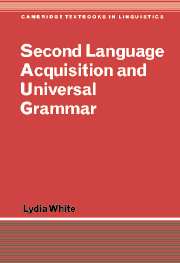Book contents
- Frontmatter
- Contents
- Preface
- Abbreviations
- 1 Universal Grammar and language acquisition
- 2 Principles of Universal Grammar in L2 acquisition
- 3 The initial state
- 4 Grammars beyond the initial state: parameters and functional categories
- 5 The transition problem, triggering and input
- 6 Morphological variability and the morphology/syntax interface
- 7 Argument structure
- 8 Ultimate attainment: the nature of the steady state
- Glossary
- Notes
- References
- Index
8 - Ultimate attainment: the nature of the steady state
Published online by Cambridge University Press: 05 June 2012
- Frontmatter
- Contents
- Preface
- Abbreviations
- 1 Universal Grammar and language acquisition
- 2 Principles of Universal Grammar in L2 acquisition
- 3 The initial state
- 4 Grammars beyond the initial state: parameters and functional categories
- 5 The transition problem, triggering and input
- 6 Morphological variability and the morphology/syntax interface
- 7 Argument structure
- 8 Ultimate attainment: the nature of the steady state
- Glossary
- Notes
- References
- Index
Summary
Introduction
The research discussed so far has explored the nature of interlanguage representations during the course of L2 development, investigating the extent to which interlanguage grammars are constrained by UG, from the initial state onwards. As we have seen, according to some accounts, adult interlanguage grammars fail to conform to principles or parameters of UG(e.g. Clahsen and Hong 1995; Neeleman and Weerman 1997), whereas on other accounts they are UG-constrained acquisition. In other words, they are no longer L2 learners but, rather, bilingual (or multilingual) speakers or users of the L2.
In L1 acquisition, it is presupposed that all acquirers of the same language or dialect achieve essentially the same steady state (barring ‘pathological’ exceptions). Indeed, much research in current linguistic theory is addressed towards discovering and describing that endstate, in other words, the nature of linguistic competence. In contrast, relatively little is known about the steady-state grammars of L2 speakers. Intuitively, it might seem obvious: (i) that L2 speakers differ from each other in their ultimate attainment, even in the case of speakers with the same L1 who have acquired the same L2; and (ii) that the endstate grammars of L2 speakers differ from the native-speaker steady state.
In fact, it should not be taken for granted that non-native performance by L2 speakers necessarily indicates basic qualitative differences between the grammars of L2 speakers and native speakers.
- Type
- Chapter
- Information
- Second Language Acquisition and Universal Grammar , pp. 241 - 272Publisher: Cambridge University PressPrint publication year: 2003



